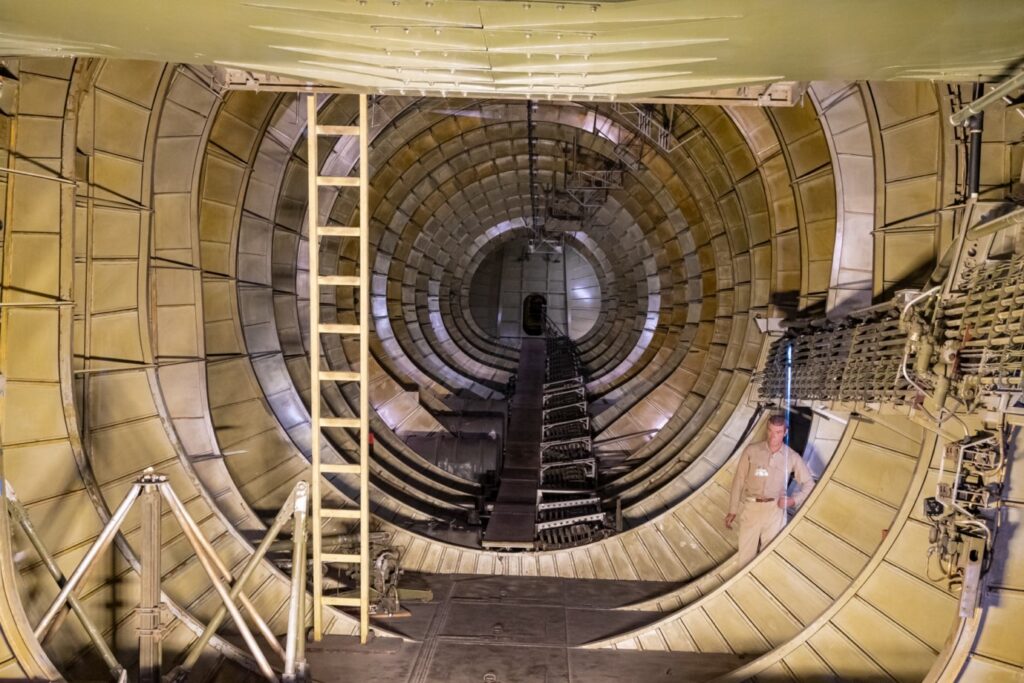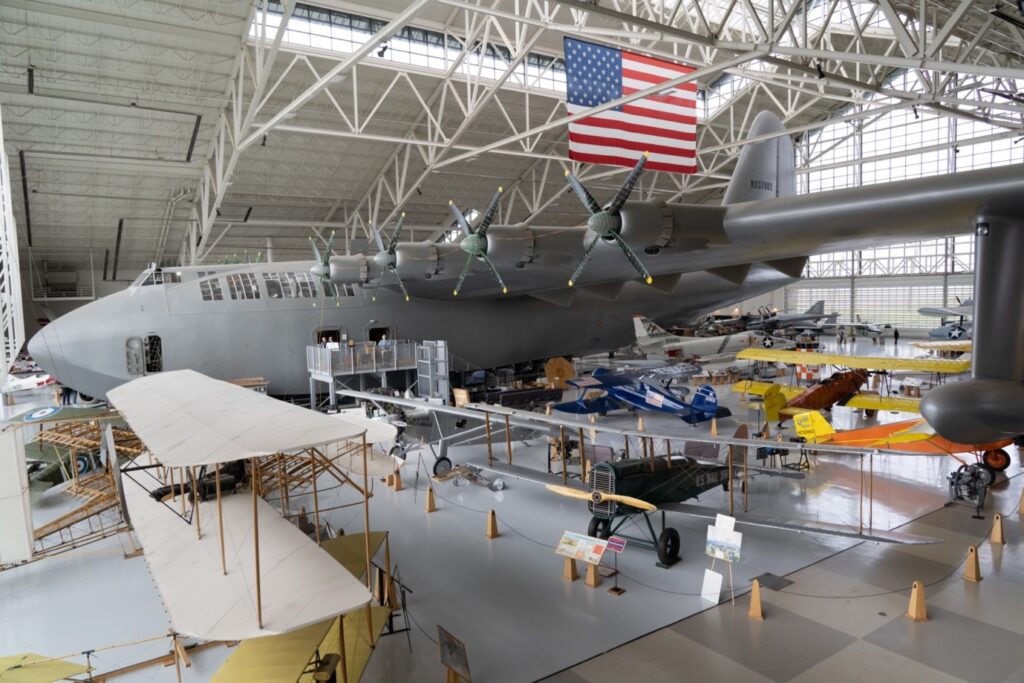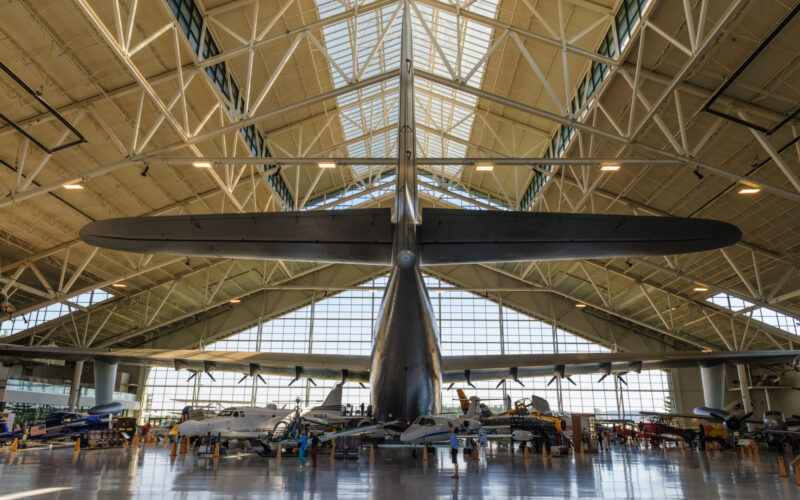The Spruce Goose – or to use its official name, the Hughes H-4 Hercules – holds a significant place in aviation history as the largest flying boat ever constructed. Designed and built by Howard Hughes and his team of engineers at the Hughes Aircraft Company, the aircraft was a response to the need for a cargo plane capable of transporting troops and equipment over long distances during World War II.
Origins and history
The origin and history of the Spruce Goose are rooted in the needs and challenges faced by the United States (US) military during World War II. In 1942, the country found itself in a pressing situation whereby large-scale transportation of troops and supplies across the Atlantic Ocean was essential. Identifying this demand, Howard Hughes, an American business magnate, aviator and engineer, conceived of a colossal flying boat that could fulfill this critical role.
Hughes believed that a massive aircraft capable of carrying significant payloads over long distances would be the solution to the transportation challenges at hand. Thus, the development of the Spruce Goose began, under the auspices of the Hughes Aircraft Company.
One challenge at the time was the scarcity of materials caused by the wartime prioritization of resources for military purposes. Metal was primarily allocated for military aircraft and other war-related applications, leaving wooden construction as a viable alternative for the vehicle. Therefore, the nickname ‘Spruce Goose’ stemmed from its primary construction material: although the aircraft was not made entirely of spruce, the name captured its wooden structure. The use of wood also allowed for design flexibility and ease of construction.

Technical characteristics
The Spruce Goose featured remarkable technical characteristics that set it apart from other aircraft of its time. With a wingspan of 320 feet (97.5 meters) and a length of 218 feet (66.5 meters), it surpassed any other aircraft in size. Even today, the Spruce Goose remains the second-largest aircraft in the world in terms of wingspan, behind the Scaled Composites Stratolaunch. The aircraft was powered by eight radial engines and had the capacity to carry up to 750 fully equipped troops or two Sherman tanks. The world would have to wait two decades for another aircraft, the Boeing 747, to be able to carry a similar payload.
| Technical Characteristic | Description |
| Wingspan | 320 feet (97.5 meters) |
| Length | 218 feet (66.5 meters) |
| Height | 79 feet (24 meters) |
| Empty Weight | 250,000 pounds (113,400 kilograms) |
| Maximum Takeoff Weight | 400,000 pounds (181,400 kilograms) |
| Powerplant | 8 × Pratt & Whitney R-4360 Wasp Major radial engines |
| Engine Power | 3,000 horsepower each |
| Fuel Capacity | 14,000 US gallons (63,645 liters) |
| Maximum Speed | 250 mph (400 km/h) |
| Range | 3,000 miles (4,800 kilometers) |
| Crew | Up to 3 |
| Capacity | Up to 750 troops or two Sherman tanks |
The historic flight
After years of development and delays, the Spruce Goose made its first and only flight on November 2, 1947. Piloted by Howard Hughes himself, the aircraft successfully took off from the waters of Long Beach, California. It flew for approximately one mile at an altitude of 70 feet before safely landing.
This historic flight showcased the engineering prowess behind the Spruce Goose and demonstrated its ability to take flight.
The development of the Spruce Goose took several years, with its completion and eventual first flight occurring after the end of World War II. The conclusion of the war, and the subsequent changes in transportation needs, impacted the fate of the aircraft. By the time the Spruce Goose was ready for flight, advancements in land-based transport had made large flying boats less practical for commercial operations.
Lack of commercialization
The lack of commercialization of the Spruce Goose can be attributed to a combination of factors that emerged after its successful flight. One of the primary reasons was the changing landscape of post-World War II transportation. Advancements in land-based transport, and the development of faster and more efficient airplanes, made the need for a massive flying boat like the Spruce Goose less relevant. Instead, commercial airlines shifted their focus onto conventional aircraft that could offer greater speed, capacity and cost-effectiveness.
Additionally, the Spruce Goose faced practical challenges due to its immense size. Its massive wingspan and overall dimensions made it difficult to accommodate in existing infrastructure such as hangars or decks. Suitable waterways for takeoff and landing also existed in limited numbers. These factors made the operations and maintenance of the Spruce Goose more complex and costly when compared to other aircraft designs.
Furthermore, the operational costs associated with the Spruce Goose were significantly higher than those of conventional aircraft. The eight powerful radial engines required substantial fuel consumption, and the maintenance and upkeep of the wooden structure necessitated specialized expertise and resources. The combination of these factors made the Spruce Goose economically impractical for commercial operations.
Current location and legacy
Today, the Spruce Goose is on display at the Evergreen Aviation & Space Museum in McMinnville, Oregon, USA. The museum provides visitors with an opportunity to witness the grandeur of the aircraft and learn about its history and significance.
The Spruce Goose serves as a testament to the engineering innovation and ambition of its time, showcasing the capabilities of the Hughes Aircraft Company and the visionary mind of Howard Hughes. It remains an iconic symbol within the field of aviation.

New similar aircraft developments
New developments in aircraft, particularly in the seaplane sector, have brought advancements in terms of landing on water and incorporating modern materials and design. Companies like Dornier Seawings and de Havilland Canada have introduced seaplanes such as the Dornier Seastar and the DHC-3 Otter. These aircraft utilize composite materials and modern engineering techniques to enhance performance and efficiency in amphibious aviation. While they may not feature wooden construction, they exemplify the Spruce Goose’s innovation in seaplane technology.

